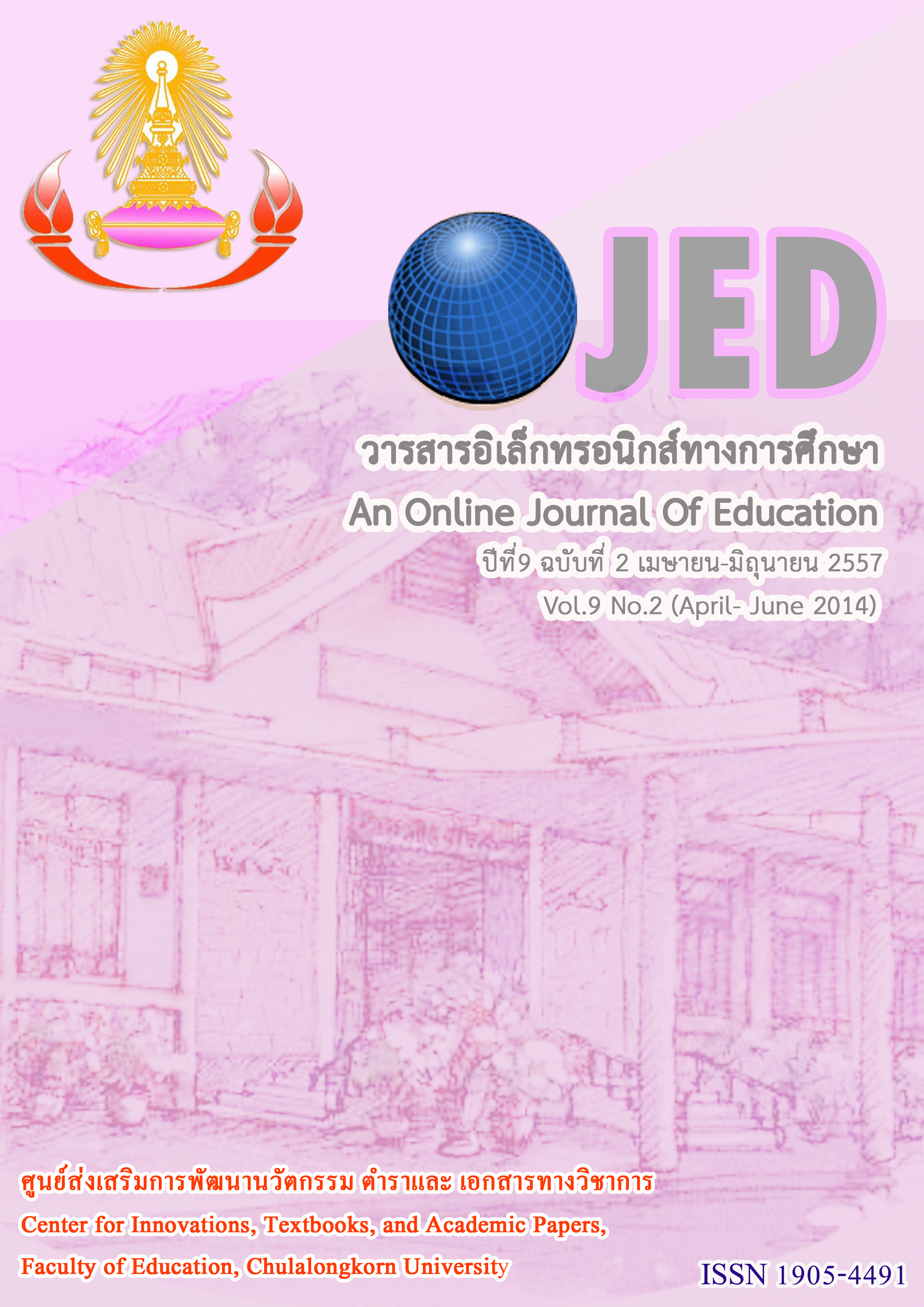การวิจัยและพัฒนากลยุทธ์การวิจัย เพื่อยกระดับการรู้วิทยาศาสตร์
Keywords:
การวิจัยและพัฒนา, การรู้วิทยาศาสตร์, วิธีวิจัยแบบผสม, RESEARCH AND DEVELOPMENT, SCIENTIFIC LITERACY, MIXED METHOD RESEARCHAbstract
การวิจัยนี้มีวัตถุประสงค์เพื่อ 1) ศึกษาลักษณะกลยุทธ์การวิจัย เพื่อยกระดับการรู้วิทยาศาสตร์ ที่มีการใช้อยู่ในปัจจุบัน 2) สร้างและพัฒนากลยุทธ์การวิจัย เพื่อยกระดับการรู้วิทยาศาสตร์ และ 3) ศึกษาผลการใช้กลยุทธ์การวิจัย เพื่อยกระดับการรู้วิทยาศาสตร์ ที่มีต่อการเปลี่ยนแปลงการเรียนรู้วิทยาศาสตร์ของนักเรียน เป็นการวิจัยและพัฒนา กลุ่มตัวอย่าง คือ นักเรียนชั้นมัธยมศึกษาปีที่ 3 ใช้วิธีวิจัยแบบผสม โดยใช้การสัมภาษณ์เชิงลึกจำนวน 5 รายกรณี ใช้วิธีการวิจัยเชิงทดลอง การสนทนากลุ่ม เครื่องมือในการวิจัยใช้แบบวัดการรู้วิทยาศาสตร์ และวิเคราะห์ผลด้วยการวิเคราะห์ความแปรปรวนตัวแปรร่วมพหุนาม (MANCOVA) ผลการวิจัยพบว่า 1) ลักษณะกลยุทธ์การวิจัย เพื่อยกระดับการรู้วิทยาศาสตร์ สังเคราะห์ได้ทั้งสิ้น 11 กลยุทธ์วิจัย ได้แก่ กลยุทธ์การปฐมนิเทศเพื่อเข้าใจคำว่า วิจัย กลยุทธ์การจัดทำบันทึกวิจัยนักเรียน (LOG BOOK) กลยุทธ์การค้นพบปัญหาวิจัย กลยุทธ์การกระตุ้นการทำวิจัย กลยุทธ์คาดเดาคำตอบอย่างรอบคอบ กลยุทธ์การวางแผน กลยุทธ์ออกแบบเพื่อความจริงที่รัดกุม กลยุทธ์การตรวจสอบความก้าวหน้า กลยุทธ์การสรุปผล กลยุทธ์การฝึกนำเสนอที่ดีและกลยุทธ์การนำเสนอและประเมินผล 2) สร้างและพัฒนาแผนกลยุทธ์การวิจัย เพื่อยกระดับการรู้วิทยาศาสตร์ ทั้ง 11 กลยุทธ์การวิจัย ภายใต้กิจกรรมการเรียนรู้ CRP ทั้งสิ้น 10 แผนการจัดการเรียนรู้ ประกอบด้วยรูปแบบการสอนแบบตกผลึก (C) 4 แผน รูปแบบการสอนด้วยวิธีวิจัย (R) 4 แผนและรูปแบบการสอนเชิงผลิตภาพ (P) 2 แผน 3) ผลการใช้แผนกลยุทธ์การวิจัย เพื่อยกระดับการรู้วิทยาศาสตร์ ภายใต้กิจกรรมการเรียนรู้ CRP พบว่านักเรียนที่เรียนด้วยแผนกลยุทธ์การวิจัย เพื่อยกระดับการรู้วิทยาศาสตร์ มีคะแนนการรู้วิทยาศาสตร์สูงกว่ากลุ่มที่เรียนด้วยวิธีปกติ อย่างมีนัยสำคัญทางสถิติที่ระดับ 0.05 (Pillai’s Trace: p = 0.00, Wilks’ Lambda: p = 0.00, Hotelling’s Trace: p = 0.00 Roy’s Largest Root: p = 0.0)
The purposes of this research were 1) to study research strategies used in the classroom nowadays for improving students’ scientific literacy, 2) to develop research strategies from the present strategies for improving scientific literacy for Matthayomsuksa students, and 3) to study the effects of these research strategies on the learning progress of the students. The study used a mixed method research design. It started by using in-depth interviews with five cases, comprising of five teachers and the study used an experiment design into focus group interviews. The research instrument was a scientific literacy test and the data from this test were analyzed by using MANCOVA.
The research findings are summarized, as follows: 1) There were eleven groups of the research strategies found to help improve students’ scientific literacy, namely a strategic orientation to help students understand the concept of research, a record of the students’ research strategies (LOG BOOK), strategies for finding the research problems, strategies for motivating students to conduct research, strategies for a careful anticipation of the research results, a strategic work planning, a strategy for careful planning the research design, strategies for monitoring progress, strategies for eliciting and discussing the results, strategies for practicing the presentation of the results, and strategies for presentation and evaluation. 2) The research strategies for improving scientific literacy were developed from the eleven groups of strategies. The development was undertaken within the concept of Crystal-Based, Research-Based, Productivity-Based Instructional Model (CRP). The eleven strategies were incorporated into ten CRP learning activities, four strategies in the crystal-based learning activities, four strategies in the research-based learning activities, and two strategies in the productivity-based learning activities. 3) The experimental group in which students engaged in CRP learning activities with eleven groups of research strategies scored higher on the scientific literacy test than the controlled group at a significant level of 0.05 (Pillai’s Trace: p = 0.00, Wilks’ Lambda: p = 0.00, Hotelling’s Trace: p = 0.00 Roy’s Largest Root: p = 0.0).



